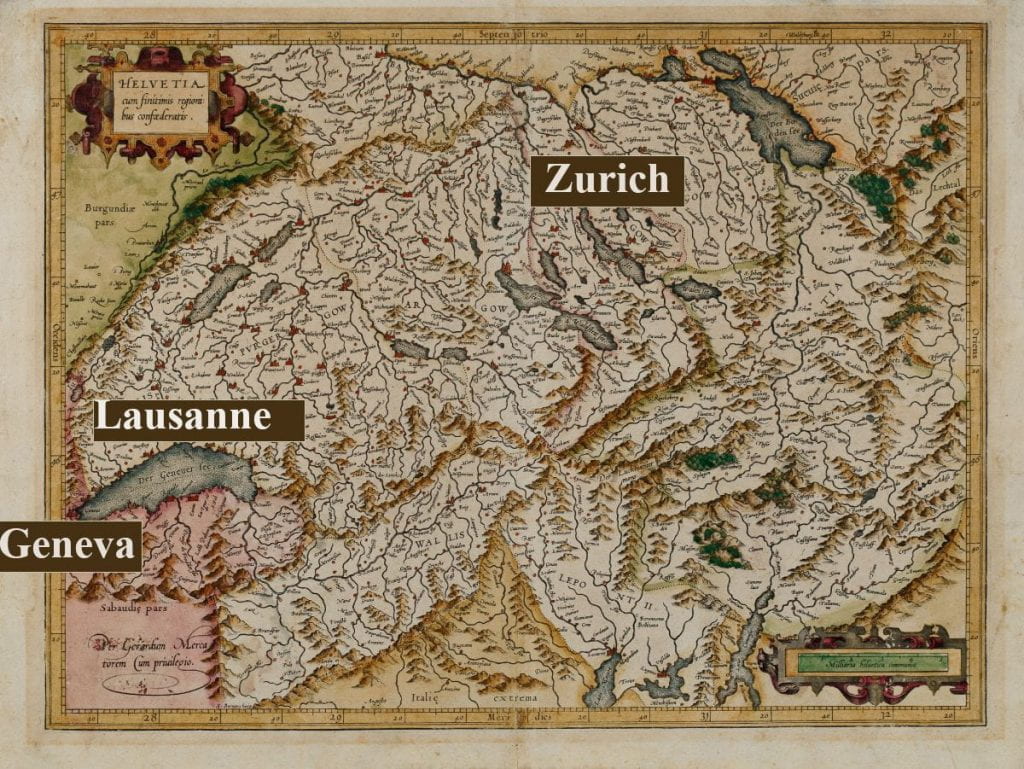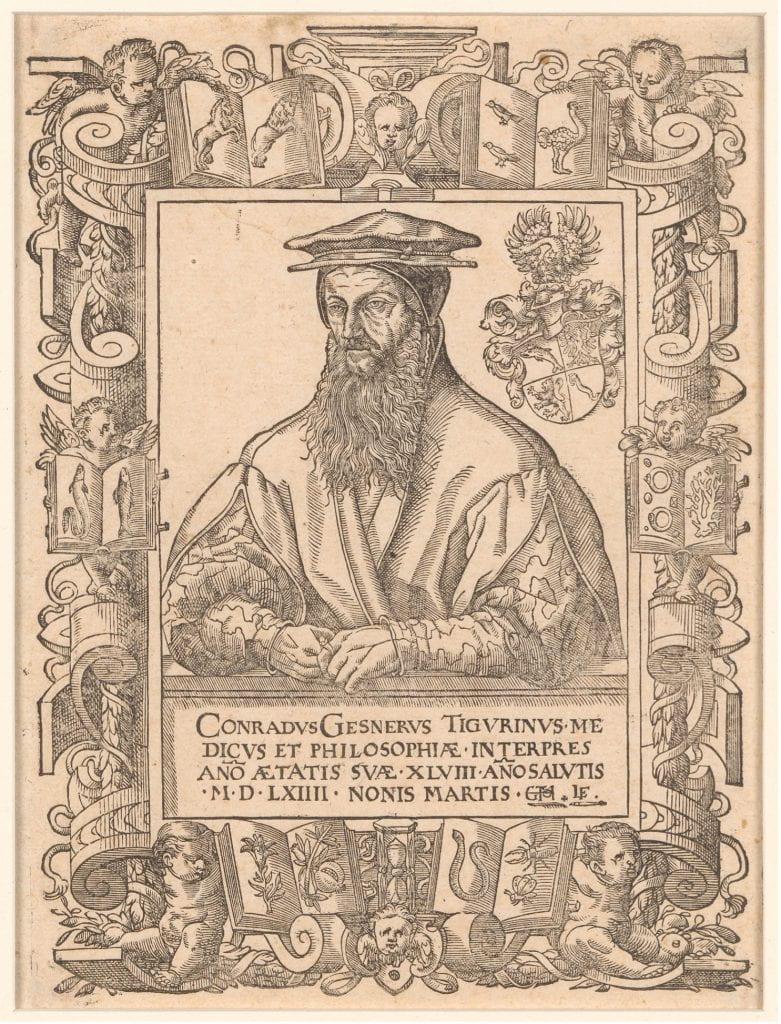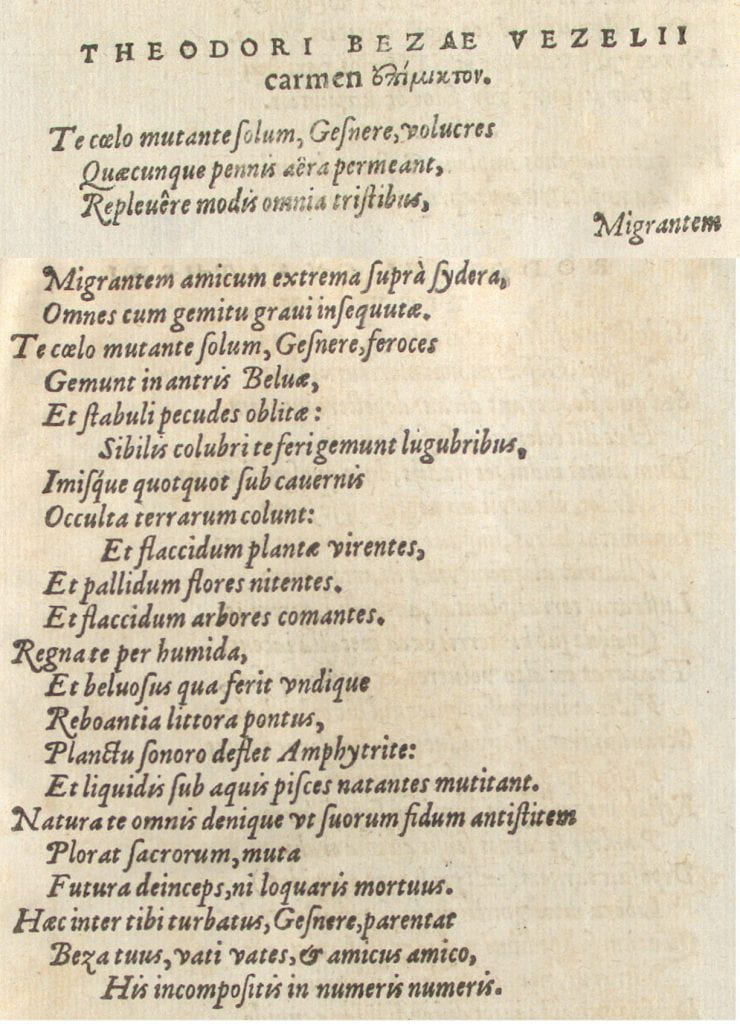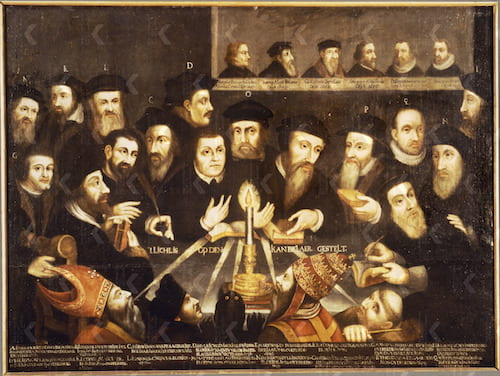By Anja-Silvia Goeing
Although routinely neglected by scholars, ephemeral poetry can teach us much about social networks and networks of knowledge in the early modern period. Sixteenth-century religious reform and the proliferation of scholarship through the new means of the printing press fostered many sorts of communication between scholars from different fields of knowledge. Here, ephemeral literature in particular reveals otherwise unknown connections between religious reform and the development of general knowledge in the sciences. Such was the case with the obituary poem written by the Genevan reformer Theodore Beza (1519–1605) about his former colleague, the physician and polymath Conrad Gessner (1516–1565). As a close study of this poem illustrates, the text is entangled in a complex network of exchange that revolved around the middlemen who helped memorialize Gessner and proved both cross-confessional and stretched across multiple disciplines of knowledge.

At Geneva, Theodore Beza, a French aristocrat, humanist, scholar of Greek, and Calvin’s confidant and colleague of old, had been spokesperson for the Genevan Academy since its inception in 1559 (see featured image above). In this office, he sat down at the end of the year 1565 and wrote a beautiful poem to bemoan the death of Conrad Gessner (see Fig. 2), a Zurich humanist, polymath, medical doctor, and fellow Greek scholar who taught natural philosophy and ethics at the Zurich lectorium. Heinrich Bullinger, antistes or religious leader of the Zurich church at the time, had asked Beza for a contribution to a multi-part scholarly obituary, as we know from a letter that Bullinger wrote to Beza on December 18. Josias Simmler, professor of Theology at the Zurich theological seminary, put the obituary together and Christoph Froschauer, the largest Zurich printer, published it in February 1566. The final eulogy contained Gessner’s biography and more than twenty poems in Greek and Latin composed by students, colleagues, former colleagues, and members of the Protestant church, including Beza’s. Half a year after his request, on June 9, 1566, Bullinger thanked Beza profusely for his contribution.
There had been an ongoing dialog between the two centers of Reformation, Geneva and Zurich, about their different versions of Protestantism (see Fig. 1). Calvin had introduced Protestantism to the city state Geneva under the protection of Savoy as early as 1536. By 1551, with the Consensus Tigurinus, a document which attempted to unite Protestant positions on the sacraments, he had connected his interpretation of the Bible to the similar interpretation that Huldrych Zwingli had introduced to the Swiss city-state of Zurich much earlier. The two religious leaders, Jean Calvin in Geneva and Heinrich Bullinger (see featured image above), successor of Zwingli in Zurich, were very close and called each other “brothers in spirit.” One of Calvin’s institutions to confirm and to spread the new religious belief was the Genevan Academy, an institution that combined school and semi-university structure. The Genevan Academy was the younger sister of the Zurich lectorium or theological seminary, but recruited students more widely than the former. The Zurich lectorium was initiated by Zwingli and established between 1523 and 1525, and Beza’s contribution to a collection published in Zurich was effectively part of this ongoing dialog between the religious leaders of the two cities.

Beza’s poem was eventually also published as an annex to a printed biography that was spearheaded by Simmler, Gessner’s younger colleague, and published by Christoph Froschauer, a Zurich printer who had issued many prior books authored by Gessner. The memorial biography was published shortly after February 22, 1566, as the preface mentioned (VIII kalendas Martii), two months and nine days after Gessner’s death on December 13, 1565. Gessner (see Fig. 2) had been one of the groundbreaking natural philosophers of the sixteenth century, a renowned and prolific author of encyclopedias about animals, plants, and stones. He turned large bodies of multi-language information and graphic illustration into books of scholarly and general knowledge, which were frequently reprinted even long after his death. The first meeting of Gessner and Beza took place in the house of the charismatic religious reformer, Greek scholar and university professor Melchior Volmar at Bourges in 1534. In 1537, Beza, who was rector of the new Lausanne Academy before moving to Geneva, offered Gessner a teaching position as a lecturer of Greek. Gessner, who had recently married, accepted the offer and stayed in Lausanne until 1540.
At Lausanne, Gessner began his first major explorations of nature. In the dedication to his rhetoric teacher and mentor Johann Jacob Ammann that is included in his Catalog of Plants (1542), Gessner recalled his three years in Lausanne, where he collected, identified, and described plants and flowers for his studies in botany. In the most recent biography of Gessner, Urs Leu discusses botanical notes and sketches that Gessner jotted down on his frequent excursions from Lausanne into Western Switzerland and the Canton of Valais, which are noteworthy for Gessner’s novel studies of alpine plants. At the time, Gessner was heavily involved in studying medicine in the evenings, after he had finished teaching Greek. After a year of further study at Montpellier, he eventually passed his medical doctoral exam at the University of Basel in 1541. Since Gessner and Beza would not find themselves again at the same place after these three years, Beza’s lyrical poem, with its allusions to Gessner’s many studies and books on nature, may have recalled precisely Gessner’s time in Lausanne.

In his obituary poem about Gessner, Beza wrote in 1565 (translation by Theodore Delwiche):
When you, Gessner, left earth for heaven,
wherever the birds soared with their wings, they
filled everywhere with sorrowful songs.
With heavy heart they followed a friend
vanishing above the distant stars.
When you, Gessner, left earth for heaven,
ferocious beasts growled in their grottos
and the farm animals left their stable.
Wild snakes mourn you with heartbroken hissings,
and as many as earth’s hidden creatures
dwell underground in the deepest caves.
And the vigorous plants [mourn you,] lifeless,
And the bright flowers [mourn you,] pale,
And the trees in full leaf [morn you,] withered.
Through the watery regions,
to the shores echoing everywhere
that the savage sea beats,
Amphitrite loudly laments you.
Fish swimming under the glistening waters interchanging places.
At last, nature in its entirety weeps for the faithful priest
of its rites, unless you dead
would later say those silent rites.
During all this, Gessner, your distraught Beza,
poet to poet, friend to friend,
pays homage to you with
these unordered, unmusical numbers.
Beza added an explanatory sentence in prose (translation by Theodore Delwiche):
After Conrad Gessner of Zurich, a leader in his piety and all other accompanying virtues, investigated all nature’s secrets and then happily travelled all the way to heaven, Theodore Beza of Vezelay, grieving, sets forth [this poem].
Beza paints a metaphorical picture of nature, flora and fauna, land and sea rich with monsters, mourning Conrad Gessner’s death and somewhat perturbed by his absence.
Beza’s poem with its vivid evocation of Gessner’s importance was frequently reproduced in the following decades. In 1580, Beza himself published the Icones … verae imagines virorum … illustrium, a work on illustrious men of his century, where he again included the poem on Gessner. Following suit in 1587, the Protestant Silesian lawyer, humanist, and polyhistor Nicolaus Reusner similarly memorialized Gessner. Putting together a book of icons of the most famous men of letters, he used Beza’s beautiful words to introduce Gessner to the reader of his encyclopedia and dedicated the volume to Frederick II of Denmark. In fact, Reusner directly took over Beza’s poem from Simmler’s earlier memorial book, to which Reusner had also contributed a short poem. While Beza reprinted his 1580 poem in a volume of collected poetry in 1598, Melchior Adam published an encyclopedia of famous physicians in Protestant Heidelberg in 1620. Adam’s work was dedicated to the government of the Silesian city of Breslau (today Wroclaw in Poland). It mentioned Gessner, printed Beza’s 1566 poem, and also included a short version of Simmler’s biography.
A 1711 translation of Simmler’s biography of Gessner into German, however, did not include the poem or any other appendix from the original Latin edition. Fatefully, it was this German edition of the work that became the most cited reference work with regard to the physician’s life and work. Later encyclopedias, such as the Universal-Lexicon of Johann Heinrich Zedler (1706–1751) from the first half of the eighteenth century or the General biography of famous Germans from the nineteenth century, the basis of the modern General biography of Germans that is still in use today, all draw on Simmler’s work—without mentioning its lyrical parts. In the process of translation and dissemination, the wonderful poem had been lost.
What Gessner brought to the table of collectorship and scholarship in sixteenth-century Europe is extensive and the object of much current interest. In this context, we can take Beza’s poem as an indication of what he, as a contemporary Reformation leader, thought of Gessner. Beza viewed him as a master—not of religious reform like himself, but of a new and groundbreaking understanding of flora and fauna both on land and in water. Moreover, Beza honors Gessner’s work as equivalent to that of an antistes or religious leader, as Gessner gave names to the creatures of nature and contextualized them within their proper environments and living conditions. He thus gave a voice to those who otherwise would not be able to give a voice to themselves, revealing (and organizing) their place in the chain of life for a more general audience.
Accordingly, Beza celebrated Gessner’s work for a novel reading of nature while also placing it within a worldview that was fueled by the new reading of the Bible as the word of God. Moreover, with its public appreciation, Beza’s poem was actively tying Gessner’s observations and collections to the views of the Protestant church. Beza’s authoritative promotion of Gessner also became manifest in his Icones … verae imagines virorum … illustrium (1580), in which he presented a series of biopics of different reformers that he then connected to a broadly understood Protestant church, revealing his wide-reaching and irenic approach. In an entry that immediately preceded that of John Calvin, Beza reproduced a woodcut portrait of Gessner, a brief synopsis of his achievements, and his poem in its entirety.
But are we doing justice to Gessner if we call his work a contribution to a Protestant natural philosophy? Should we see the work of the two most important encyclopedists of natural philosophy in the sixteenth and early seventeenth centuries, the Italian naturalist Ulisse Aldrovandi (1522–1605) of Bologna and the German Jesuit polymath Athanasius Kircher (1602–1680) as contributions to a Catholic or re-catholicized natural philosophy? We have ample proof that all three authors read and responded to notes and observations emerging from groups of other confessions. We also know that Gessner’s work was read by scholars of all confessions—including members of the Catholic church, in spite of its general ban by the Index Librorum Prohibitorum, a list of publications which were seen as heretical. At the John Rylands Library in Manchester, for instance, a rare annotated copy of Gessner’s study De Anima (1563) survived which had previously been stored and read in the Catholic Piarist monastery library of Löwenburg in Austria. Gessner’s findings were thus included in a trans-confessional history of the study of nature, which would eventually merge into our modern fields of the natural sciences. Gessner organizes nature by gathering evidence, collected by means of human observation. His very delicate visual depictions of flowers (see Fig. 4), which he dissects for the reader in order to visualize and describe their individual parts, give testimony to his acute observational skills.

The term of a Protestant natural philosophy has been used in studies on the existence of networks of Protestant correspondents and the role they played in the transmission of ideas. This term has similarly been used in reference to groups of Protestant merchants who traded both in wares and in books. In fact, such commercial exchanges allowed the Protestant publisher Johann Heinrich Zedler to take notice of Gessner’s biography and to include it in his Universal-Lexicon. This circulation of ideas and texts within Protestant networks was based on middlemen and mediators who made these exchanges of information between different networks possible in the first place. Some of them, such as ambassadors at court, held positions of power as they brought missing information into new contexts. As recent studies that focus on the strength of these go-betweens suggest, it can be quite fruitful to examine the important crosslinks between networks of different confessions that led early modern natural philosophy and medicine into the modern age.
But Beza’s poem also raises the question of the role of verse in the appraisal and distribution of early modern scientific knowledge. His poem forges a strong link between Gessner’s work, lyrical literature as practiced by erudite poets, and the world of Protestant leadership in his lifetime. Beza’s use of natural imagery in the poem also reveals his own interest in natural history. In his theological work, Beza included the organization and identification of nature based on studies of different confessional backgrounds in an effort to confirm his belief. Using a poetic form, Beza was able to express an appreciation of Gessner’s field of knowledge, which historians familiar with Beza’s religious work may have overlooked. Beza even discussed Gessner’s history of animals in his Brevis … zographia Joannis Cochleae (1549). Its dedication letter to Gessner is one of the very few documents of correspondence between Beza and Gessner known today.
The history of Beza’s poem alerts us to the value of such ephemeral works in tracing the exchanges and links between religious reformers and scholars of natural philosophy in the early modern period. Beza’s championing of Gessner’s natural philosophy also leads us to ask new questions: How did Beza integrate natural philosophy in his own religious beliefs? To what degree could Gessner’s natural philosophy and Beza’s reformed theology be brought into harmony? In the specific case of Beza, a first step in tackling these questions would be to look into the Genevan Academy and inquire about how he equipped the school he was leading for so many years in order to teach natural philosophy to students, and how—by extension—he shaped the transmission of the ideas, methods, and results of Gessner’s research. After all, as a close study of emphemeral poetry suggests, Beza’s social networks had a lasting influence on the production of knowledge in early modern intellectual history.
Acknowledgements
This think piece is indebted to Philippe Schmid, who asked me to contribute to the JHI Blog; to Ann Blair’s fascination for those parts of books that usually remain uncited, such as prefaces, indexes, list,s and other paratexts; to Urs Leu, Florike (M. F.) Egmond, and Sachiko Kusukawa for their recent work on Conrad Gessner’s botanical drawings; to Paul Michel’s and Kaspar von Greyerz’s long-standing observations in physico-theology and its Protestant relations; and to John Brewer’s many discussions of middle figures in scientific networks for the edited volume Information: A Historical Companion (2021). I am especially thankful for Theodore Delwiche’s translation of the poem and its added explanatory sentence from Latin into English. Theodore (Teddy) R. Delwiche is a PhD student in History at Yale University. A Gessner website is currently in progress at Harvard University, to be publicly viewable from 2023.
For more information on the poem discussed here, readers can refer to these notes on the translation.
Anja-Silvia Goeing is Professor at the University of Zurich and Associate in History at Harvard University. Her main fields of teaching and study are higher education and the history of information in early modern Europe, broadly conceived. You can find out more about her research on her professional website.
Featured Image: Anonymous from the Dutch Republic, second half of the seventeenth century (?). Group portrait of sixteen reformers accompanied by the motto ’t Licht is op den kandelaer gestelt. Oil on canvas, 96×126 cm. Utrecht, Museum Catharijneconvent. Courtesy of Wikimedia Commons.



